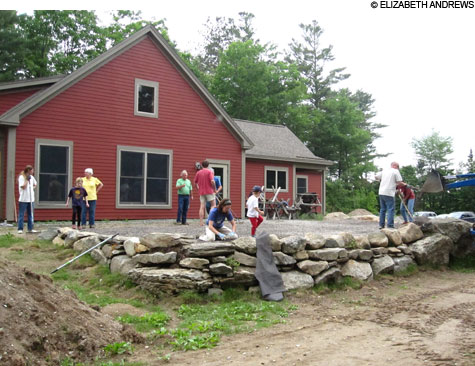
COLLECTIVE WORKDAY Residents share maintenance responsibilities at Two Echo Cohousing in Brunswick. |
An architect, a professor, a dentist, and a teacher. Children as young as six and retirees in their 60s and 70s. Musicians and massage therapists and artists; Mainers and folks from away. All living together, sharing common space, learning to accommodate each other's whims while living their individual lives to the fullest. It's not the premise of a new reality show — it's the model for a co-housing development in Belfast that broke ground this month and will eventually comprise 36 private residences, plus common space, on 40 acres of midcoast farmland.
"It's not really houses we're selling," says Sanna McKim, one of the co-founders of the Belfast Cohousing and Ecovillage; she'll there with her husband and two children when construction is complete. "It's community. We want to have a little more to do with our neighbors."
As author and environmentalist Bill McKibben says in his introduction to the recently reissued Creating Cohousing: Building Sustainable Communities (New Society Publishers), "the average American eats meals with friends, families, neighbors, half as often as fifty years ago. The average American has half as many close friends." Thanks to technology, the pressures of money and work, and sprawl, we've become isolated, like islands.
However, whether as a result of financial necessity or as an expression of certain values, collaboration and shared resources are increasingly commonplace. (Keep in mind that tent cities are springing up all over the country.) Cohousing is nothing less than a piece of a larger movement — one that embraces community over the cold realities of the rat-race. In a society where a safety net is more crucial than ever, cohousing instills a restored sense of "neighborhood" — of caring for each other, of helping each other.
"[T]he cohousing community is a wonderful challenge, the best kind of challenge: it doesn't tsk tsk at Americans for their selfish ways, it just offers them a subtly different take on how the future might unfold," McKibben says.
Cohousing projects can coalesce around a shared interest (such as art or music), demographic (several exist purely for older citizens, for example), or design element (the Belfast homes will be extremely energy efficient), but there are some fundamental commonalities: community dinners; shared childcare responsibilities; work groups for maintenance, gardening, or farming; community government that is often based on consensus; and ongoing interaction with neighbors.
Little of this is mandatory, although misanthropes and those disinclined to participate in group activities are unlikely candidates for cohousing; most communities require that residents sign up to cook one group meal every month or few months, with such common dinners occurring once or twice a week, and commit to a certain number of maintenance, landscaping, or home-improvement hours per month or year. In a high-functioning cohousing system, expectations regarding participation are clear, as are consequences.
In some ways, the cohousing village is like an enhanced condo association with communal perks and shared values. Residents have their own income sources — the community does not serve as a revenue-generator, except in rare instances — and homes are individually owned and financed.
Of course, these types of arrangements present unique challenges.